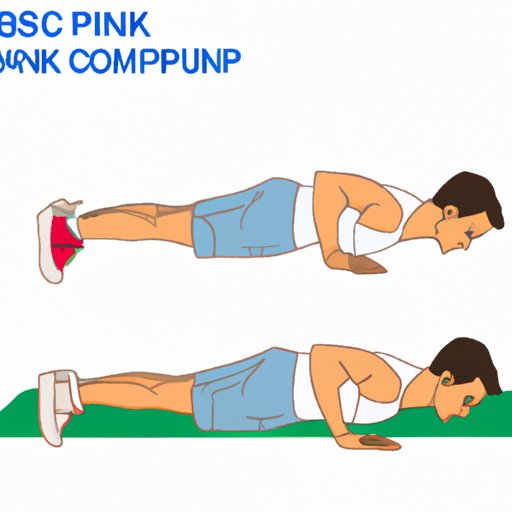Introduction
Planks exercise is one of the most popular bodyweight exercises used to build core strength and stability. This exercise involves holding your body in a straight line while balancing on your toes and forearms. It works all of the muscles in your core, including your abs, back, and hips. Planks can be done with just your bodyweight, or they can be modified to make them easier or more challenging. With proper form and regular practice, planks can help you build strength and improve your posture.
How to do Planks Exercise for Beginners
If you’re new to planks, it’s important to start with the basics. Here’s how to do a basic plank:
- Start by getting into a push-up position on your hands and toes.
- Lower your forearms to the ground so that your elbows are directly below your shoulders.
- Engage your core by tightening your abdominal muscles.
- Hold this position for 30 seconds to 1 minute.
- Release and repeat as needed.
It’s important to maintain proper form when doing planks. Keep your head in line with your spine and focus on engaging your core throughout the entire exercise. Make sure your hips aren’t sagging towards the floor and that your back isn’t arching. If you’re feeling any pain or discomfort in your neck or back, stop immediately and consult your doctor.

Different Types of Planks Exercise
Once you’ve mastered the basic plank, you can start to explore other variations of the exercise. Here are some of the most popular types of planks:
Front Plank
The front plank is the most common type of plank. It involves holding your body in a straight line while balancing on your toes and forearms. To make the exercise more challenging, you can raise one leg off the ground at a time.
Side Plank
The side plank is similar to the front plank, but instead of facing forward, you are facing sideways. This variation targets the muscles on the sides of your body, including your obliques and abductors. Again, you can make the exercise more challenging by raising one leg off the ground at a time.
Reverse Plank
The reverse plank is a variation of the side plank, but instead of facing sideways, you are facing up. This variation works your lower back, glutes, and hamstrings. To make the exercise more challenging, you can raise one leg off the ground at a time.
Bird Dog Plank
The bird dog plank is a combination of the front plank and the bird dog exercise. To do this variation, start in a front plank position and then lift one arm and the opposite leg off the ground. Hold this position for a few seconds before returning to the starting position. Repeat on the other side. This exercise works your core, arms, and legs.
Plank Jacks
The plank jacks is a dynamic variation of the front plank. To do this exercise, start in a front plank position and then jump your feet out to the side, like you would when doing jumping jacks. Jump your feet back to the starting position and repeat. This exercise works your core and cardiovascular system.
Plank Up/Downs
The plank up/downs is another dynamic variation of the front plank. To do this exercise, start in a front plank position and then lower one arm at a time to the ground. Push yourself back up and repeat on the other side. This exercise works your core and upper body.

Modifications to Make Planks Easier or More Challenging
Planks can be modified to make them easier or more challenging, depending on your fitness level. Here are some ways to modify planks to make them easier:
- Do planks from your knees instead of your toes.
- Raise your arms up on a bench or box.
- Use an exercise ball to support your weight.
- Do planks against a wall instead of on the floor.
And here are some ways to modify planks to make them more challenging:
- Slow down the movement.
- Add weights to your arms or legs.
- Hold the plank for longer periods of time.
- Do explosive planks (e.g. jumping jacks or claps).
The Importance of Proper Form When Doing Planks
Maintaining proper form when doing planks is essential for maximizing the benefits of the exercise and minimizing the risk of injury. Here are some of the benefits of maintaining proper form:
- Improved balance and stability.
- Increased core strength and muscle tone.
- Reduced risk of injury.
- Better posture.
When doing planks, it’s important to avoid common mistakes such as arching your back, sagging your hips, or hunching your shoulders. Maintaining proper form will help you get the most out of the exercise and reduce the risk of injury.

Tips for Making Planks a Regular Part of Your Workout Routine
Planks are an excellent exercise that can be incorporated into any workout routine. Here are some tips for making planks a regular part of your routine:
- Set goals and track your progress. For example, aim to hold a plank for one minute or 20 seconds longer than your previous best.
- Incorporate planks into other exercises. For example, do a set of push-ups followed by a set of planks.
- Work planks into your daily routine. For example, do a few sets of planks while watching TV or during commercial breaks.
Conclusion
Planks exercise is an excellent bodyweight exercise that builds core strength and stability. It can be done with just your bodyweight, or it can be modified to make it easier or more challenging. It’s important to maintain proper form when doing planks to maximize the benefits of the exercise and minimize the risk of injury. With regular practice and proper form, planks can help you build strength and improve your posture.


